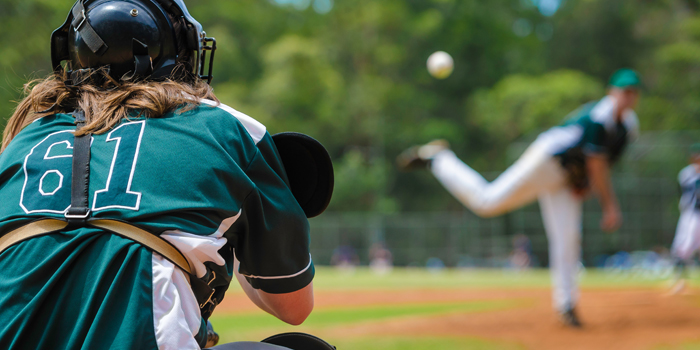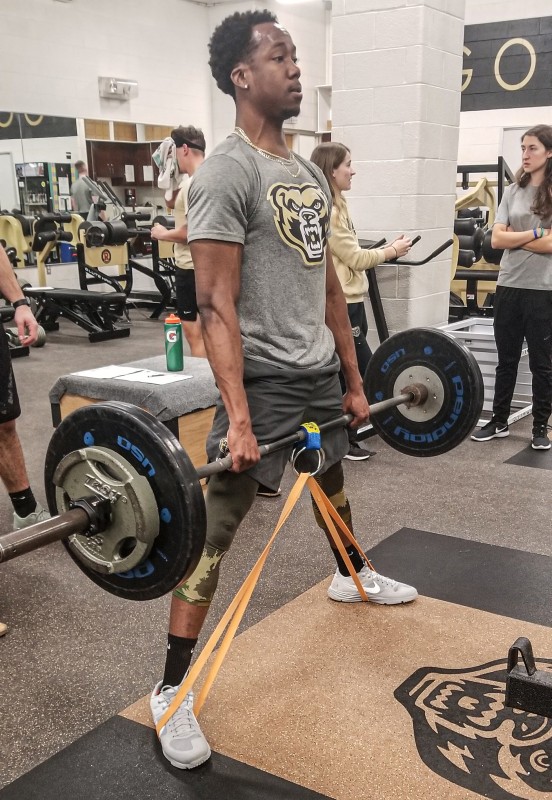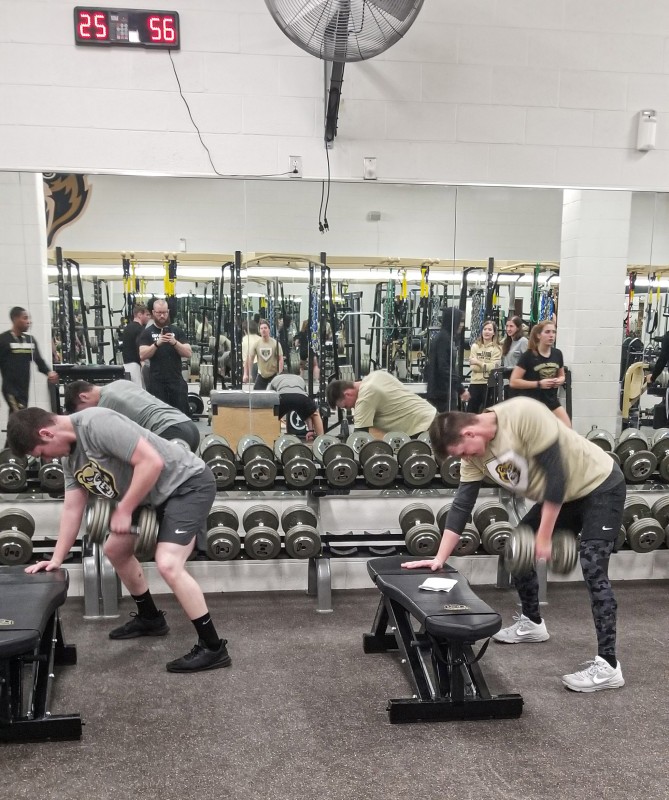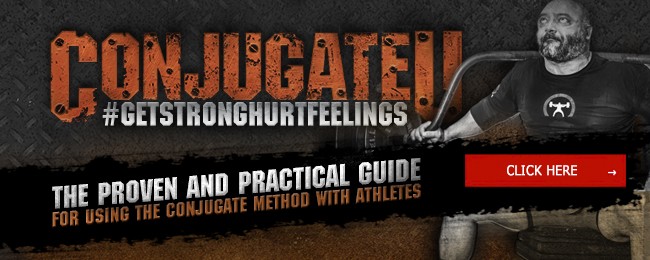
Let me ask you something—as a strength and conditioning coach, how many times have you heard or been told the following statements:
“Baseball players shouldn’t bench press.”
“Baseball players shouldn’t lift heavy.”
“Squats and deadlifts will make you big and bulky and slow you down.”
“Conjugate doesn’t work for raw lifters or athletes.”
I could keep going, but you get the idea. We’ve heard all the arguments, all of which boil down to one very incorrect philosophy—baseball players shouldn’t lift. Heaven forbid athletes whose success depends on their ability to produce and direct force over a very acute period of time be trained to do that very thing, but I digress.
RECENT: Conjugate U for Collegiate Tennis
The purpose of this article is not to disprove the arguments against strength training for baseball athletes, at least not directly, but rather to explore and discuss the effectiveness of the conjugate method as the primary means of training for a collegiate baseball population.

A brief bit of background—I’m a collegiate strength and conditioning coach at a Division I university located in Michigan and am responsible for baseball, softball, women’s soccer, swimming, and the throwers. We, meaning my director and myself, use conjugate with all of our teams and have seen great success both in the weight room and in the various arenas of competition. There are, as every coach knows, other components of competition that factor into success and failure, many of which are beyond our scope of practice and immediate sphere of influence, so it’s challenging to quantify just how successful our training has been in regards to improving overall sports performance and securing victories. However, we all like to believe that we’re important and I don’t want to write myself out of a job, so I’ll argue that the success we’re having in the weight room is a contributing factor to athlete success.
This article will outline, in brief, the means by which conjugate was implemented with our baseball program. It will seek to explore the progression of movements/exercises, as well as the overall driving philosophy behind the implementation of the method as a whole.
We started conjugate from day one. I would imagine that some coaches might want to start a new semester with a more linear progression, but my rationale was that if I wanted to run conjugate as the primary means of training, I needed to get it rolling ASAP. We needed to teach the box squat (which we now use exclusively with all of our teams), the sumo deadlift, max effort, dynamic effort, and the use of accommodating resistance — all in a very finite amount of time.
The first couple of weeks were spent getting comfortable with the movements. Per Nate Harvey’s suggestions, we spent most of our time performing modified speed work (10x2, 8x3) to allow for time under tension and the proper application of force through the movement. This allowed the athletes time to build a technique foundation and develop some neuromuscular coordination and recruitment without the weight of a true or circa ME load on them. I found that this protocol served us rather well and I would definitely do it again in the future, though perhaps with some refinement to volume and intensity.
After week three or four we moved into true ME work. Now, I say “true ME work” but what I really mean is “almost true ME work.” By this I mean that, for the most part, I never take our athletes to a true ME level. Some of them, in their infinite capacity to take things too far, manage to get there anyway, but I like to pull them back just shy of a real ME attempt.
I do this not because I’m afraid to push a kid, and there are times when I’ll take the reins off and let a kid push to that level, but I don’t want to risk a kid’s season, or career, for the sake of a few more pounds. Yes, I value strength, and want our kids to be strong, but at the same time, they’re here to graduate and play their sport, not lift, and I would be remiss if I were to think any differently. Again, I’ll be damned if I risk a kid’s season/career/health for a few pounds. I often cringe at the argument that conjugate doesn’t work or isn’t applicable for athletes, because they’re not powerlifters and don’t need to train as such, but in this case, and in this case only, I agree.
Once we got into ME work, it was full steam ahead. We perform a number of variations in the squat, bench, and deadlift, including pauses, bands, chains, grip/stance width, concentric only, etc. I probably went a little overboard with the number of variations we performed, but I wanted to keep things fresh, avoid stagnation, and keep the kids engaged. Honestly, we could have gotten away with rotating just a couple of variations for each lift over a few weeks, but where’s the fun in that?
My guys get after their ME work. Not all of them are meatheads, but more and more are becoming such, and there are a hefty handful who love to push and get after it. I’ve got a few guys pulling over 500 (one is a pitcher), a few guys knocking at the door of squatting 500, and a few guys pressing 300+ (including a freshman position player). Obviously, there are those guys who don’t want to push and do the minimum amount to not get called out, but I would say that 95 percent of the team really pushes, and those who don’t get pulled along with the majority and end up working harder than they meant to.
On our ME days, we jump or throw, depending on the day. On our ME Lower days, we perform a variation of the box jump, either standing or seated, weighted or not, medicine ball or not. On our ME upper days, we perform some variation of a medicine ball throw—right now, either a shot put or what I call a scoop throw (throwing from the hip). I like to change things up every three weeks or so (this holds true for accessory work as well), to keep things fresh and to train multiple movement patterns so we’ll sometimes throw from a kneeling or half-kneeling position.

Regarding the evil and shoulder-wrecking bench press—our position guys press on the bench with a straight bar (minus one who feels more comfortable with a neutral grip bar—we use the American Press Bar from elitefts), and our pitches use, again, the American Press Bar, but perform a floor press (don’t worry gurus, we dumbbell bench, too). I’m not scared to bench a pitcher or use a straight bar, but the combination of the neutral grip and the floor press makes them feel better, meaning I get better quality work, so I’m all for it. One big lesson that I’ve learned in my short career is that there are times when you have to pick your battles, and I’m not willing to fight over this because why should I?
The intensity of our ME work is matched, or even outpaced, by that of our DE work. I get my guys three days per week, so day one (Monday) is ME Lower, day two (Wednesday) is ME upper, and day three (Friday) is a DE upper/lower combo day. Our DE day looks like this:
- Pre-training (usually a medicine ball throw variation)
- Speed bench (9x3, either mini bands or chains)
- Speed squat (three-week wave, 8/8/6x3, bands or chains)
- Speed pull (three-week wave, 10/10/8x1, bands or chains)
- Accessories (typically just abs, back, and band work)
That’s A LOT of work, in a very short amount of time. If we’re in week one, they’re performing 27 reps of bench, 24 reps of squat, and 10 reps of deadlift, and usually 100 reps of band leg curls and triceps extensions, so, at minimum, they’re doing 261 reps of work inside of a 45-minute window (after warm-up and talking). If anyone doubts the value of GPP work, I challenge them to come train with my guys on a Friday and see what it takes to work for 45 minutes straight. At the beginning of the year, our DE day was a smoker—the guys left dripping sweat, breathing hard and heavy, and a couple even puked. Now, they still leave tired, but they’ve adapted to the work and intensity, and are no longer getting crushed. Sure, the 8x3 weeks are harder than the 6x3, but they know what I expect and walk in ready to go.
Attitude is another thing that we’ve worked to cultivate and build over the semester. Baseball was a fairly turnkey operation—once I got here and got settled into the flow and swing of things, there wasn’t much of an “adjustment” period with the team. I had a couple guys here over the summer, and used them as examples and ambassadors for the rest of the team, which made the process all the easier. But to get back to topic, my guys have a great attitude, know what I expect, and get to work with little to no direction. They know that I expect them to push themselves and each other, to challenge themselves, and to give their best effort every day. We all know that not every day is going to be a great day—some days are just trash and there’s nothing anyone can do about it, but as long as I get the best effort for that day, and I don’t catch any attitude, we’re square.
Coming into this semester, I had heard that baseball was a team that struggled with accountability, and that was something the sport coaches were looking to improve. So far, I’ve not had any issues with it. We’ve had a couple guys miss lifts, but my outlook is that everyone gets “one” and that if it happens again, then there will be consequences, but no one was late at all over the semester (7:00 am lift) and like I said, we’ve only had a couple of guys miss.
To wrap up, here are some other things that I think are important when it comes to implementing conjugate with a baseball program, or any team for that matter:
- Exercise rotation: It’s easy to over-conjugate things and throw a ton of variations out there, or to put bands and chains on EVERYTHING, but it’s not necessary. Variations are great, but they have to serve a purpose, and they have to be doable. You’re dealing with athletes, remember, not experienced lifters, so some variations (like an ascending band box squat) might be beyond their current abilities. Pick a few movements that you know are effective and rotate through them over a period of four to six weeks.
- Intensity: This should speak for itself, but in order for the ME method to work and be effective, there has to be intensity. You can’t let kids coast through a ME lift and expect to get ME results. The same can be said for DE and accessory work as well. Speed work has to be fast, and accessory work has to be challenging enough to elicit a response.
- Accessories: Pick things that make sense and are doable. You have a finite amount of time for accessory work, and if you’re adhering to the 80/20 rule, the vast majority of your volume is going to be spent doing accessories. As Louie says, special exercises (accessories) should account for 80 percent of your total volume. As such, the per-set and overall volume of your accessories has to be enough to incite growth, but not so much that it’ll crush your kids and leave them too sore to function.
- Coaching: Only program what you’ve done or what you’re able to coach. Never done a banded squat? Don’t program it. Never ran a circamax phase? Don’t have your kids do it. Never done a three-week pendulum wave? Don’t ask your kids to do it. Know your stuff, be willing to learn and admit when you’re out of your depth, and seek help when you know you don’t know. Above all, use your common sense.
- Seasonal considerations: Understand the different demands between in-season and off-season teams. Each team will need its own attention and individualized approach based on where they are in their season. An in-season team probably doesn’t need to spend as much time doing ME work as an off-season team, or might need adjustments made to the intensity of their ME work as compared to an off-season team. Be willing to modify, adjust, and adapt. Don’t get married to one philosophy over another.
I hope that this brief overview of my implementation of conjugate with our baseball program was at least slightly enlightening and revealing or, if nothing else, inspirational. It’s a simple system to implement, you just have to know what you’re doing, be willing to experiment and learn from your mistakes, use common sense, and have some fun. I’m looking forward to the coming season and the challenges it will bring. If anyone reading this would like more information, including our variations and the numbers associated with them, I’m happy to share.
RELATED: Why You Should Use the Conjugate Method for Your Athletes
At this point, I don’t have hard data, meaning pitching speed or home-to-first time, but that’s data that I’ll seek to collect and then compare over time. Like a moron, I neglected to do vertical jump testing at the beginning of the season (I was too concerned about getting things rolling that I didn’t think to do it), but I can say that just by watching the guys jump, they’re jumping higher and with more force than when they started this semester. Again, objective data is something I’ll seek to collect as we continue to move forward.
Header image credit: pripir © 123rf.com
Jim Seratt is a Division-I strength and conditioning coach at Oakland University. He has been coaching for five years, and is a 220/242 raw and multi-ply powerlifter. He is responsible for coaching baseball, softball, women’s soccer, swimming, and the throwers. He can be reached at jseratt@oakland.edu.











It's always great to see how ConjugateU is being applied in a real world setting. Thank you for taking the time to share! Awesome stuff!